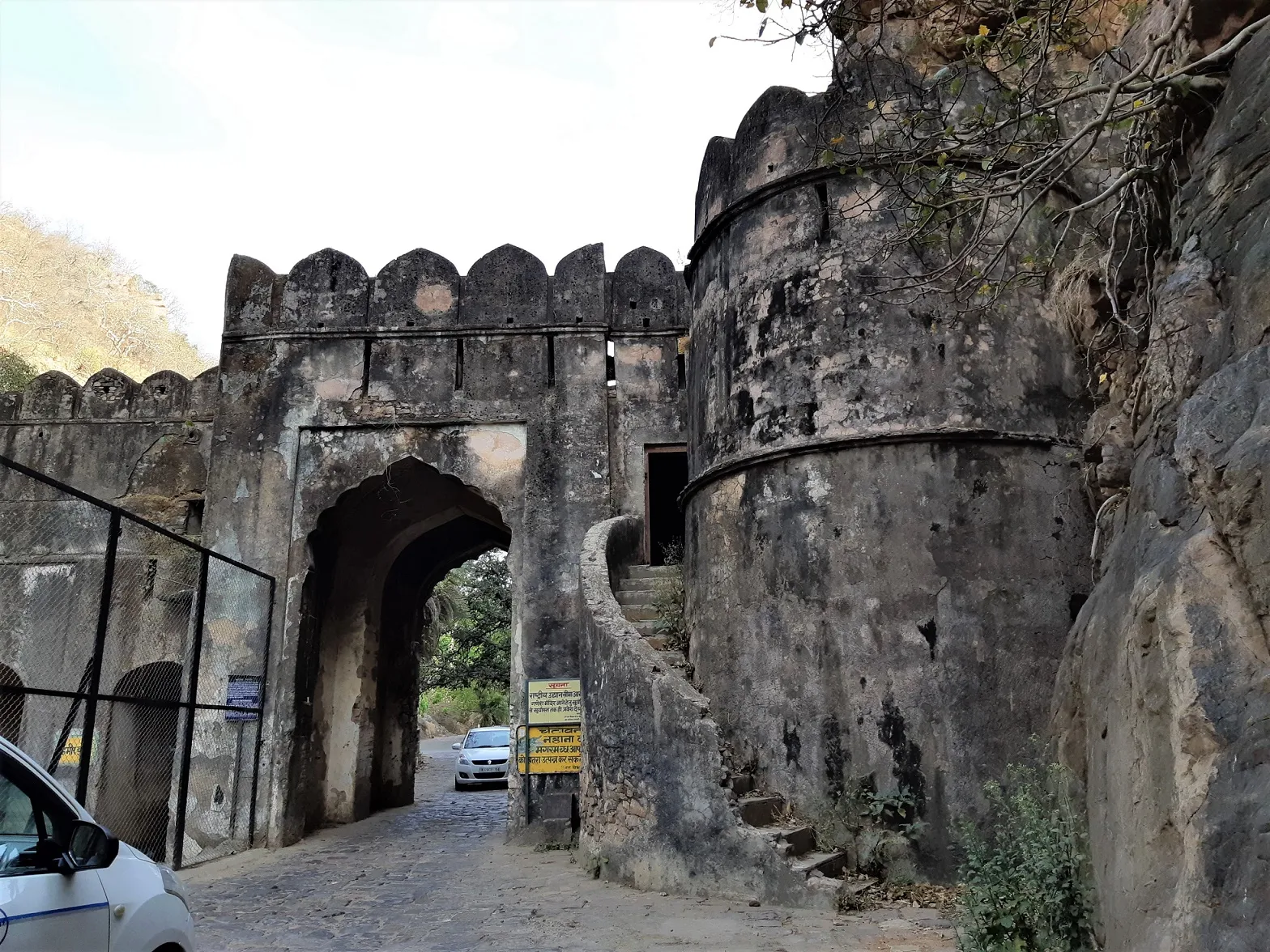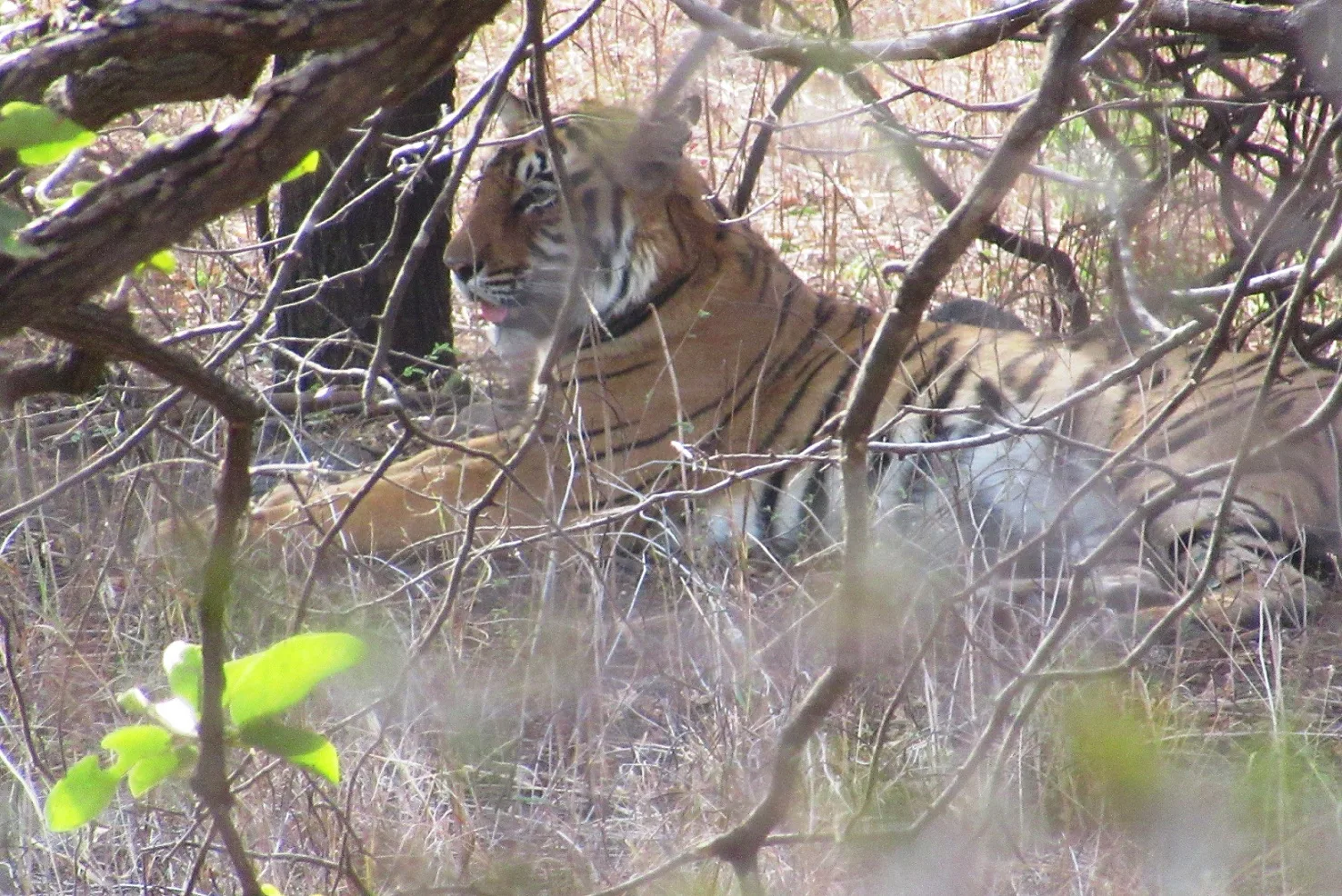Our visit to the golden city of Jaisalmer had been wonderful. From Jaisalmer, we took a train to Jaipur for one night then another train south to Sawai Madhopur, the entry point for Ranthambore National Park. We were going to the Park to find endangered Bengal tigers.
In Sawai Madhopur, we grabbed a tuktuk from the train station to our accommodation, the Rajputana Heritage. It proved to be a rather lovely place in a quiet side-street with spacious rooms, and beautiful traditional designs hand-painted on the ceilings and walls.
Upon our arrival, the Rajputana Heritage owner Vishnu, welcomed us and invited us on a trip to see the Ranthambore Fort.
 |
| Ranthambore Fort (UNESCO) |
It took no time at all to get there, but it was a long climb up to, and through the ruins of the Fort in the 40-degree heat. However, the historic and huge fortified walls, and the ruins were worth it.
 |
| Three wise monkeys? Ranthambore Fort (UNESCO) |
At one point, we were quite startled to hear a loud galloping kind of noise approaching us. Suddenly this rather large monkey (it was at least as tall as Leigh at around 1.5 metres), went thumping toward us at great speed. We were pleased it wasn’t interested in us as it zoomed past.
 |
| Marg at the hill top Ranthambore Fort (UNESCO) |
Before we left New Zealand, we researched the best place and time to spot Bengal tigers in India. Based on that, we ended up booking three tiger safaris at Ranthambore National Park, so we were hopeful of seeing at least one tiger over the next few days.
The next morning, we were picked up at 6 am for our first safari. Our vehicle was a canter, which is an open-top 4-wheel-drive truck that carries about 20 people.
It was a bumpy and dusty ride into the Park, but we saw lots of peacocks and other colourful birds, monkeys, deer varieties, crocodiles, and Indian wild boar.
There are no fences in this park, but there are controlled zones that tour operators must work within, aimed at protecting the tigers and their habitat. This means that safari operators must pre-book with the Park authorities, then stay within the booked zone.
 |
| Our first tiger sighted |
We were driven closer and the cameras were clicking like crazy. More canters and also jeeps arrived, which didn't seem to worry the tiger. She walked on while vehicles jostled for space around her.
Then she crossed the path right in front of us. We were very close to her and had a great view.
 |
Our tiger cooling off |
She seemed to be really hot, and walked to a waterhole where she plopped her butt-end into the water to cool off. Once refreshed, she continued on her walk, right past the vehicles and into a different zone of the park so we had to stop following her. We carried on in Zone 4 seeing many other animals, but no more tigers on that safari.
At 3 pm that afternoon, we set out in an open-top jeep for our second tiger safari. Along with our guide and driver, we were joined by one other person, and headed for Zone 6. This zone had an entirely different landscape, consisting of large open grassland with some distant hills.
We passed a variety of deer, including sambar, chital (or spotted deer), nilgai deer, and Indian gazelle. There were lots of monkeys, and we saw two jackals and several wild boars. We also saw the footprints of a sloth bear, but we didn't see the bear.
Before long, we spotted another tiger, a large male, sitting under a tree in the shade.
 |
| Our 2nd tiger, sitting in the shade |
Towards the end of our safari, we went back to see if the sleeping tiger was still there. He was, and he was awake and sitting up.
He was really big and had very beautiful markings.
As he slowly awoke, he rolled over and stretched like a pussy-cat before getting up and walking away. We were so pleased to have seen a second tiger on the same day.
Another early start the next morning, saw us in a jeep for our third safari. There were six of us aboard, and we headed for the Park’s Zone 5.
The habitat in this zone was greener than the parched look of the other two zones. We spotted more monkeys and deer in the shade of the trees, as well as a mongoose, and different birds.
Then suddenly we saw a young female tiger walking parallel to us, but seeing us, she sat down, watching us. Wow!
Then a noisy canter arrived and she stood and disappeared into the long grass. We felt so privileged to have seen her, and with only us there initially.
Moving on, we came to a congregation of jeeps and canters, which is a sure sign that a tiger is close-by.
Yes, there were two tigers, a female and a male. They were much harder to see than our earlier tigers, as they were camouflaged in the grass and scrub. Eventually, the female moved in one direction out of our sight, and the male wandered down toward a stream and then away.
We couldn't believe we had been so lucky to see so many Bengal tigers on one safari! Some people go on these safaris and don't get to see a single tiger, and we saw five over two days. Our research on tigers paid off.
The next day, we picked up some supplies in Sawai Madhopur, then headed for the railway station. We had a 6-hour train ride to Delhi, then one night in a hotel there, before embarking on our long flight back home to New Zealand - our time in India at an end.
We have been travelling for over two months, and we've seen some incredible sights, and met so many lovely people.
The history of this immense country is absolutely amazing, and we have been stunned by how ancient many of the towns and sights are, especially compared to New Zealand, a relatively young country in terms of human habitation. With that in mind, we have prepared a short ode to India.
Ode to India:
India the Great they call it, and it certainly is that we see;
from its very diverse population, to its past, and geography;
the villages and cities so rich in culture, if not in material goods;
with beliefs that go back centuries, she would move forward if only she could;
but her progress is slow and stately, with a democratic style;
her beauty, colour and temperament keeping it fresh all the while;
the food is really tasty if you like a little spice;
and she's well known for her tea, and varieties of rice;
India the Great, you are fascinating, and also very strong;
we look forward to visiting again, before very long.
It’s been a great trip in a wonderful country, and we recommend that travellers add it to their bucket list.







